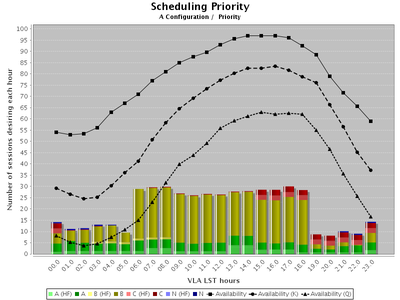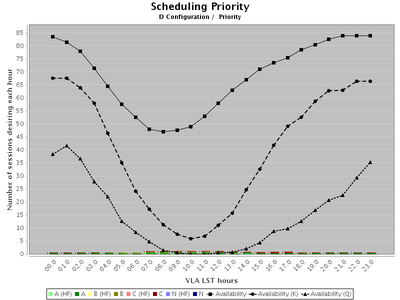Proposal Guide
VLA Configuration Plans and Science Time Available
The 1 August 2017 deadline covers the observing period 02 March 2018 through 24 September 2018 (Semester 2018A), corresponding to the A and D configurations. Multi-configuration proposals that include either of these configurations may also be submitted. Additionally, proposals requesting only configurations that will fall in semester 2018B (or later) may be submitted if the Principal Investigator is a graduate student. NRAO offers this service to provide scientific and technical feedback for students, and to provide them with an opportunity to re-submit their proposals for their principal semester with this information in hand. Students should ensure that their status is up to date and correct in the NRAO User Database. Please refer to the VLA Configuration Plans for details and availability of upcoming configurations.
Note that semester 2016A was the last semester NRAO offered any hybrid configuration. Proposers with very southern or northern targets should consult the Array Configurations section of the Guide to Proposing for the VLA on how to combine principal configurations to obtain similar surface brightness sensitivity to the hybrids.
Plot of estimated available observing hours as a function of LST and weather conditions for the A and D configurations in semester 2018A are below. In this plot, engineering, maintenance, and testing cause the solid (upper) line to be less than the total number of LST days in the configuration; such activities occur predominantly during daytime.
Estimated science time available per LST hour is shown by the solid (upper) black line for all frequencies, the dashed (middle) line for K-band conditions, and dotted (lower) line for Q-band conditions. The colored bars show time already committed in previous proposal rounds, where green represents priority A, yellow priority B, and red priority C. For the net available time in either configuration per LST hour subtract the bars of the pre-committed time from the black curve.
Observing Capabilities for Semester 2018A
The capabilities offered for 2018A through our General Observing (GO) program are identical to those offered for 2017B; details are given in the Offered VLA Capabilities during the Next Semester section of the Observational Status Summary (OSS) and are summarized in the following table. Several additional capabilities are available to proposers through the Shared Risk Observing (SRO) and Resident Shared Risk Observing (RSRO) programs, as described below.
| Capability | Description |
|---|---|
|
8-bit samplers |
Standard default setups for:
Flexible setups for spectroscopy, using two, independently tunable, 1 GHz baseband pairs, each of which can be split into up to 16 flexibly tunable subbands Single, dual, and full polarization products |
|
3-bit samplers |
Standard default setups for:
Flexible setups for spectroscopy, using four, independently tunable, 2 GHz baseband pairs, each of which can be split into up to 16 flexibly tunable subbands Single, dual, and full polarization products |
|
Mixed 3-bit and 8-bit samplers |
Allows more flexibility for simultaneous continuum and high-resolution spectral line observing |
|
Subarrays |
Up to 3 independent subarrays using standard 8-bit continuum setups |
|
Phased array for VLBI |
Both single pointing and mosaics with discrete, multiple field centers will be supported. Data rates up to 25 MB/s (90 GB/hour) will be available to all users and, with additional justification, data rates up to 60 MB/s (216 GB/hour) will be available. Correlator integration time limits per band and per array configuration also apply as described in the OSS. The data rate and total data volume required by a proposal will be a consideration in its technical evaluation.
There are some limitations on frequency settings and tuning ranges, especially at Ka-band; please consult the OSS for further details. Additionally, the Exposure Calculator has been updated and other special tools are available to assist users with the development of correlator setups for the proposal deadline (see VLA Proposal Submission Guidelines). All antennas employ electronics and receiver systems that provide continuous frequency coverage from 1–50 GHz in the following observing bands: 1–2 GHz (L-band); 2–4 GHz (S-band); 4–8 GHz (C-band); 8–12 GHz (X-band); 12–18 GHz (Ku-band); 18–26.5 GHz (K-band); 26.5–40 GHz (Ka-band); and 40–50 GHz (Q-band). In addition to these, all VLA antennas are equipped with 224-480 MHz (P-band) receivers and 14 of them are equipped with 54-86 MHz (4-band) receivers. For details see the Low Frequency Observing section below.
We continue to offer shared risk programs to our user community for those who would like to push the capabilities of the VLA beyond those offered for general use.
VLA Shared Risk Observing
The VLA Shared Risk Observing (SRO) program allows users access to capabilities that can be set up via the Observation Preparation Tool (OPT) and run through the dynamic scheduler without intervention, but are not well tested. The following capabilities are offered under the SRO program in Semester 2018A:
- On-the-Fly (OTF) mosaicing (used when each pointing on the sky is no more than a few seconds)
- 32 subbands per baseband with the 8-bit samplers
See the VLA Proposal Submission Guidelines web page for information about tools and other advice on proposing for Shared Risk observing capabilities.
VLA Resident Shared Risk Observing
The VLA Resident Shared Risk Observing (RSRO) program provides access to extended capabilities of the VLA that require additional testing. This access is provided in exchange for a period of residence to help commission those capabilities. Examples of capabilities that would fall under the RSRO program in Semester 2018A include:
- correlator dump times shorter than 50 msec, including integration times as short as 5 msec for transient detection;
- pulsar observations;
- data rates above 60 MB/s;
- recirculation beyond a factor of 64 in the correlator;
- P-band system (224–480 MHz) polarimetry and spectroscopy;
- 4-band system (54–86 MHz; see Low Frequency Observing section below);
- more than 3 subarrays, or subarrays with the 3-bit system;
- complex phased array observations (e.g., pulsar and complex VLBI observing modes); and
- frequency averaging in the correlator: a new capability for averaging to wider frequency channels in the correlator has been developed that will reduce the data volume for all continuum subbands
A detailed description of the VLA RSRO program for semester 2018A and beyond is available at the VLA Proposal Submission Guidelines web page.
Low Frequency Observing
The new low frequency receiver system developed in collaboration with the Naval Research Laboratory is available for Stokes I continuum observations at P-band (224–480 MHz) through the GO program. Use of the P-band system for polarimetry and/or spectroscopy is through the RSRO Program. The new receivers also work at 4-band (54–86 MHz), and new feeds have been deployed on fourteen VLA antennas. For the 2018A observing semester we expect some small number of additional 4-band feeds to be deployed; as many as three (taking the total to at least 17). Both 4-band and P-band can be observed simultaneously, but access to the 4-band system is only available through the RSRO program.
Commensal Observing Systems at the VLA
There are two commensal systems on the VLA that may take data at the same time as your proposed observation. The first is the VLITE system, which will take data at P-band during regular observations that use bands other than P-band. The VLITE system will be deployed on fifteen VLA antennas by the 2018A semester. Observers wishing to gain access to the commensal VLITE data taken during their VLA observations should follow the instructions on the VLITE web page for doing so. The second is the realfast system, which takes data at very fast dump rates in an effort to detect Fast Radio Bursts (FRBs). This system is still in development, but may be observing during the 2018A semester.
Proposal and Observation Preparation
Proposal preparation and submission are via the Proposal Submission Tool (PST) at NRAO Interactive Services. Use of the PST requires registration in the NRAO User Database. There are various tools and documentation to help users in this process. Descriptions of all updated documentation and tools, along with an outline of the steps required to write a proposal, are available at the Guide to Proposing for the VLA web page.
When constructing sessions in the PST, proposers should be cognizant of their use by the Time Allocation Committee (TAC). Specifically taking into account the time available as a function of LST, the TAC will assign a scheduling priority to each session in each proposal. The assigned scheduling priority will depend on the linear-rank score of the proposal from its scientific review, the LSTs involved in the session (daytime is harder to accommodate than nighttime, for instance), the predicted atmospheric conditions for observing over that LST range at the time of year of the configuration, the total time requested in the session, and the competition from better-ranked proposals requesting time at similar LSTs. Please see this description for guidance on how to set up sessions in the PST, and this document for a complete description of the VLA Prioritizer (the software that generates the initial scheduling priorities for all sessions that are subsequently used by the TAC to derive the final priorities).
All approved VLA observations are set up using the Observation Preparation Tool (OPT). Most, if not all, projects will be observed dynamically; users should submit scheduling blocks before the start of the configuration to maximize the opportunity of them being observed. Advice on the optimal length of scheduling blocks and other useful information may be found at the Observing FAQ web page.
Information about VLA capabilities, proposal preparation and submission, observing strategies, and calibration overhead can be found in the VLA Observational Status Summary, at the Guide to Proposing for the VLA, and at the Guide to Observing with the VLA. Answers to Frequently Asked Questions are contained in these proposing and observing guides. Questions may also be directed to the NRAO Helpdesk.






Connect with NRAO